Tridimensional Long-Term Finite Element Analysis of Reinforced Concrete Structures with Rate-Type Creep Approach
Abstract
:1. Introduction
2. Numerical Analysis of Creep Behavior
2.1. Integral Formulation
2.2. Rate-Type Creep Law
2.3. Aging Kelvin Chain
2.4. Non-Aging Kelvin Chain
2.5. Numerical Algorithm
3. Spectra Determination for Various Models
3.1. EuroCode 2 Model
3.2. ACI Model
3.3. B3 Model (RILEM)
4. Numerical Validation of the Finite Element Model
4.1. Numerical Simulation of a Prestressed Beam with I-Shaped Solid Cross-Section
4.2. Numerical Simulation of a Prestressed Box Girder
5. Numerical Simulation of the Long-Term Behavior of a Bridge
5.1. Structural Effects of Long-Term Deformations
5.2. Long-Term Variation of Stress and Deformation States
6. Conclusions
Author Contributions
Funding
Acknowledgments
Conflicts of Interest
Appendix A. Eurocode 2
Appendix B. ACI Model
Appendix C. Model B3
References
- Bažant, Z.P.; Jirásek, M. Creep and Hygrothermal Effects in Concrete Structures; Springer: Dordrecht, The Netherlands, 2018. [Google Scholar]
- Gilbert, R.; Ranzi, G. Time-Dependent Behavior of Concrete Structures; CRC Press: Boca Raton, FL, USA, 2010. [Google Scholar]
- Faber, O. Plastic yield, shrinkage, and other problems of concrete, and their effect on design. In Minutes of the Proceedings of the Institution of Civil Engineers; ICE Publishing: London, UK, 1928. [Google Scholar]
- Glanville, W. Studies in Reinforced Concrete-III, The Creep or Flow of Concrete Under Load; Technical Paper (Great Britain. Building Research Board) No. 12; H.M.S.O.: London, UK, 1930; pp. 1–39. [Google Scholar]
- Bazant, Z. Prediction of concrete creep effects using age-adjusted effective. J. Am. Concr. Inst. 1972, 69, 212–217. [Google Scholar]
- Granata, M.F.; Margiotta, P.; Arici, M. Simplified Procedure for Evaluating the Effects of Creep and Shrinkage on Prestressed Concrete Girder Bridges and the Application of European and North American Prediction Models. J. Bridge Eng. 2013, 18, 1281–1297. [Google Scholar] [CrossRef]
- Pisani, M.A. Behaviour under long-term loading of externally prestressed concrete beams. Eng. Struct. 2018, 160, 24–33. [Google Scholar] [CrossRef]
- Chiorino, M.A. A. A rational approach to the analysis of creep structural effects. In Shrinkage and Creep of Concrete; Gardner, N.J., Weiss, W.E., Eds.; American Concrete Institute (ACI): Farmington Hills, MI, USA, 2005; pp. 107–141. [Google Scholar]
- Park, Y.; Lee, Y.; Lee, Y. Description of concrete creep under time-varying stress using parallel creep curve. Adv. Mater. Sci. Eng. 2016, 2016, 9370514. [Google Scholar] [CrossRef] [Green Version]
- Park, Y.; Lee, Y. Incremental model formulation of age-dependent concrete character and its application. Eng. Struct. 2016, 126, 328–342. [Google Scholar] [CrossRef]
- Kim, S.G.; Park, Y.S.; Lee, Y.H. Rate-Type Age-Dependent Constitutive Formulation of Concrete Loaded at an Early Age. Materials 2019, 12, 514. [Google Scholar] [CrossRef] [Green Version]
- Bažant, Z.; Yu, Q.; Li, G.H. Excessive long-time deflections of prestressed box girders: I. Record-span bridge in Palau and other paradigms. ASCE J. Struct. Eng. 2012, 138, 676–686. [Google Scholar] [CrossRef] [Green Version]
- Bažant, Z.; Yu, Q.; Li, G.H. Excessive long-time deflections of collapsed pre-stressed box girders: II. Numerical analysis and lessons learned. ASCE J. Struct. Eng. 2012, 138, 687–696. [Google Scholar] [CrossRef]
- Di Luzio, G.; Cusatis, G. Hygro-thermo-chemical modeling of high performance concrete. I: Theory. Cem. Concr. Compos. 2009, 31, 301–308. [Google Scholar] [CrossRef]
- Di Luzio, G.; Cusatis, G. Hygro-thermo-chemical modeling of high performance concrete. II: Numerical implementation, calibration, and validation. Cem. Concr. Compos. 2009, 31, 309–324. [Google Scholar] [CrossRef]
- Di Luzio, G.; Cusatis, G. Solidification-Microprestress-Microplane (SMM) theory for concrete at early age: Theory, validation and application. Int. J. Solids Struct. 2013, 50, 957–975. [Google Scholar] [CrossRef] [Green Version]
- De Borst, R.; van den Boogaard, A.H. Finite-Element Modeling of Deformation and Cracking in Early-Age Concrete. J. Eng. Mech. 1994, 120, 2519–2534. [Google Scholar] [CrossRef] [Green Version]
- Cervera, M.; Oliver, J.; Prato, T. Thermo-Chemo-Mechanical Model for Concrete. I: Hydration and Aging. J. Eng. Mech. ASCE 1999, 125, 1018–1027. [Google Scholar] [CrossRef] [Green Version]
- Cervera, M.; Oliver, J.; Prato, T. Thermo-Chemo-Mechanical Model for Concrete. II: Damage and Creep. J. Eng. Mech. ASCE 1999, 125, 1028–1039. [Google Scholar] [CrossRef] [Green Version]
- Gawin, D.; Pesavento, F.; Schrefler, B.A. Hygro-thermo-chemo-mechanical modelling of concrete at early ages and beyond. Part I: Hydration and hygro-thermal phenomena. Int. J. Numer. Methods Eng. 2006, 67, 299–331. [Google Scholar] [CrossRef]
- Gawin, D.; Pesavento, F.; Schrefler, B.A. Hygro-thermo-chemo-mechanical modelling of concrete at early ages and beyond. Part II: Shrinkage and creep of concrete. Int. J. Numer. Methods Eng. 2006, 67, 332–363. [Google Scholar] [CrossRef]
- Bažant, Z.P.; Carol, I. Viscoelasticity with aging caused by solidification of nonaging costituent. J. Eng. Mech. ASCE 1993, 119, 2252–2269. [Google Scholar]
- Bažant, Z. Creep and Shrinkage in Concrete Structures; Mathematical Modeling of Creep and Shrinkage of Concrete; John Wiley and Sons: New York, NY, USA, 1982; pp. 163–256. [Google Scholar]
- Bažant, Z.P.; Xi, Y. Continuous retardation spectrum for solidification theory of concrete creeps. J. Eng. Mech. ASCE 1995, 121, 281–288. [Google Scholar] [CrossRef] [Green Version]
- Linczos, C. Applied Analysis; Prentice-Hall: Englewood Cliffs, NJ, USA, 1964; pp. 272–280. [Google Scholar]
- Tschoegl, N.W. The Phenomenological Theory of Linear Viscoelastic Behavior; Springer: Berlin, Germany, 1989. [Google Scholar]
- Widder, D.V. An Introduction to Transform Theory; Academic Press: New York, NY, USA, 1971. [Google Scholar]
- Jirásek, M.; Havlásek, P. Accurate approximations of concrete creep compliance functions based on continuous retardation spectra. Comput. Struct. 2014, 135, 155–168. [Google Scholar] [CrossRef]
- Bažant, Z. Mathematical Modeling of Creep and Shrinkage of Concrete; Material Models for Structural Creep Analysis; John Wiley: New York, NY, USA, 1988; pp. 99–215. [Google Scholar]
- Di Luzio, G. Numerical Model for Time-Dependent Fracturing of Concrete. J. Eng. Mech. ASCE 2009, 135, 632–640. [Google Scholar] [CrossRef] [Green Version]
- Bažant, Z.P.; Cusatis, G.; Cedolin, L. Temperature Effect on Concrete Creep Modeled by Microprestress-Solidification Theory. J. Eng. Mech. 2004, 130, 691–699. [Google Scholar] [CrossRef]
- Bažant, Z. Linear creep problems solved by a succession of generalized thermoelasticity problems. Acta Tech. ČSAV 1967, 12, 581–594. [Google Scholar]
- Bažant, Z.P.; Baweja, S. Creep and shrinkage prediction model for analysis and design of concrete structures-Model B3. Mater. Struct. 1995, 28, 357–365. [Google Scholar]
- Bažant, Z.P.; Prasannan, S. Solidification theory for concrete creep. I: Formulation. J. Eng. Mech. ASCE 1989, 115, 1691–1703. [Google Scholar] [CrossRef] [Green Version]
- Boumakis, I.; Di Luzio, G.; Marcon, M.; Vorel, J.; Wan-Wendner, R. Discrete element framework for modeling tertiary creep of concrete in tension and compression. Eng. Fract. Mech. 2018, 200, 263–282. [Google Scholar] [CrossRef] [Green Version]
- Jirásek, M.; Bažant, Z.P. Inelastic Analysis of Structures.; J. Wiley & Sons: London, UK; New York, NY, USA, 2002. [Google Scholar]
- Blodgett, O.W. Design of Welded Steel Structures; James F. Lincoln Arc Welding Foundations: Cleveland, OH, USA, 1966. [Google Scholar]
- Křístek, V.; Vítek, J.L. Deformations of prestressed concrete structures-measurement and analysis. Proceedings of fib Symposium: Structural Concrete—The Bridge Between People (fib and ČBS), Prague, Czech Republic, 12–15 October 1999; Volume 2, pp. 463–469. [Google Scholar]
- Křístek, V.; Bažant, Z.P.; Zich, M. Kohoutková, A. Box girder deflections: Why is the initial trend deceptive? ACI Concr. Int. 2006, 28, 55–63. [Google Scholar]
- Riberholt, H. Tapered Timber Beams. In Proceedings of the CIB-W18 Meeting 11, Vienna, Austria, March 1979. Paper W18/11–10–1. [Google Scholar]
- Spangler Shortreed, J.; Seible, F.; Filiatrault, A.; Benzoni, G. Characterization and testing of the Caltrans Seismic Response Modification Device Test System. Philos. Trans. R. Soc. A Math. Phys. Eng. Sci. 2001, 359, 1829–1850. [Google Scholar] [CrossRef]
- EN. EN 1992-1-1 Eurocode 2: Design of Concrete Structures—Part 1-1: General Ruels and Rules for Buildings; CEN: Brussels, Belgium, 2005. [Google Scholar]
- ISO 2736-2:1986. Concrete Tests—Test Specimens—Part 2: Making and Curing of Test Specimens for Strength Tests; International Organization for Standardization: Geneva, Switzerland, 1986; ISO/TC 71/SC 1 Test Methods for Concrete. [Google Scholar]
- American Concrete Institute Committee 209 (ACI). Prediction of Creep, Shrinkage, and Temperature Effects in Concrete Structures; ACI Rep. 209R-92; ACI: Farmington Hills, MI, USA, 1992. [Google Scholar]
- American Concrete Institute Committee 209 (ACI). Guide for Modeling and Calculating Shrinkage and Creep in Hardened Concrete; ACI Rep. 209.2R-08; ACI: Farmington Hills, MI, USA, 2008. [Google Scholar]
- Bažant, Z.; Panula, L. Practical prediction of time-dependent deformations of concrete: Part I, Shrinkage; Part II, Basic creep; Part III, Drying creep. Mater. Struct. (RILEM Paris) 1978, 11, 307–316. [Google Scholar]
- Bažant, Z.; Kim, J.K. Improved prediction model for time-dependent deformations of concrete: Part II, Basic creep. Mater. Struct. (RILEM Paris) 1991, 24, 409–421. [Google Scholar] [CrossRef]

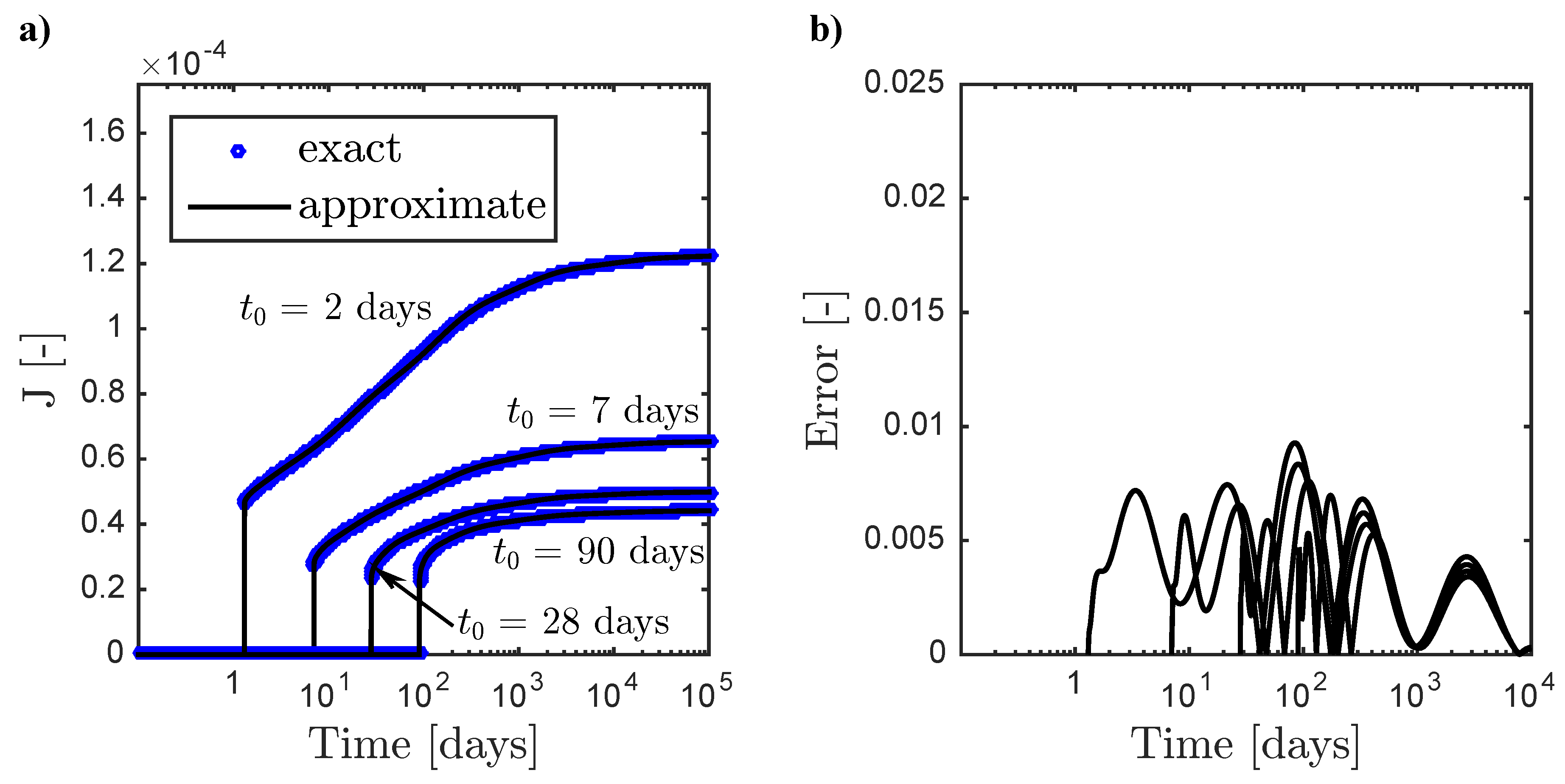
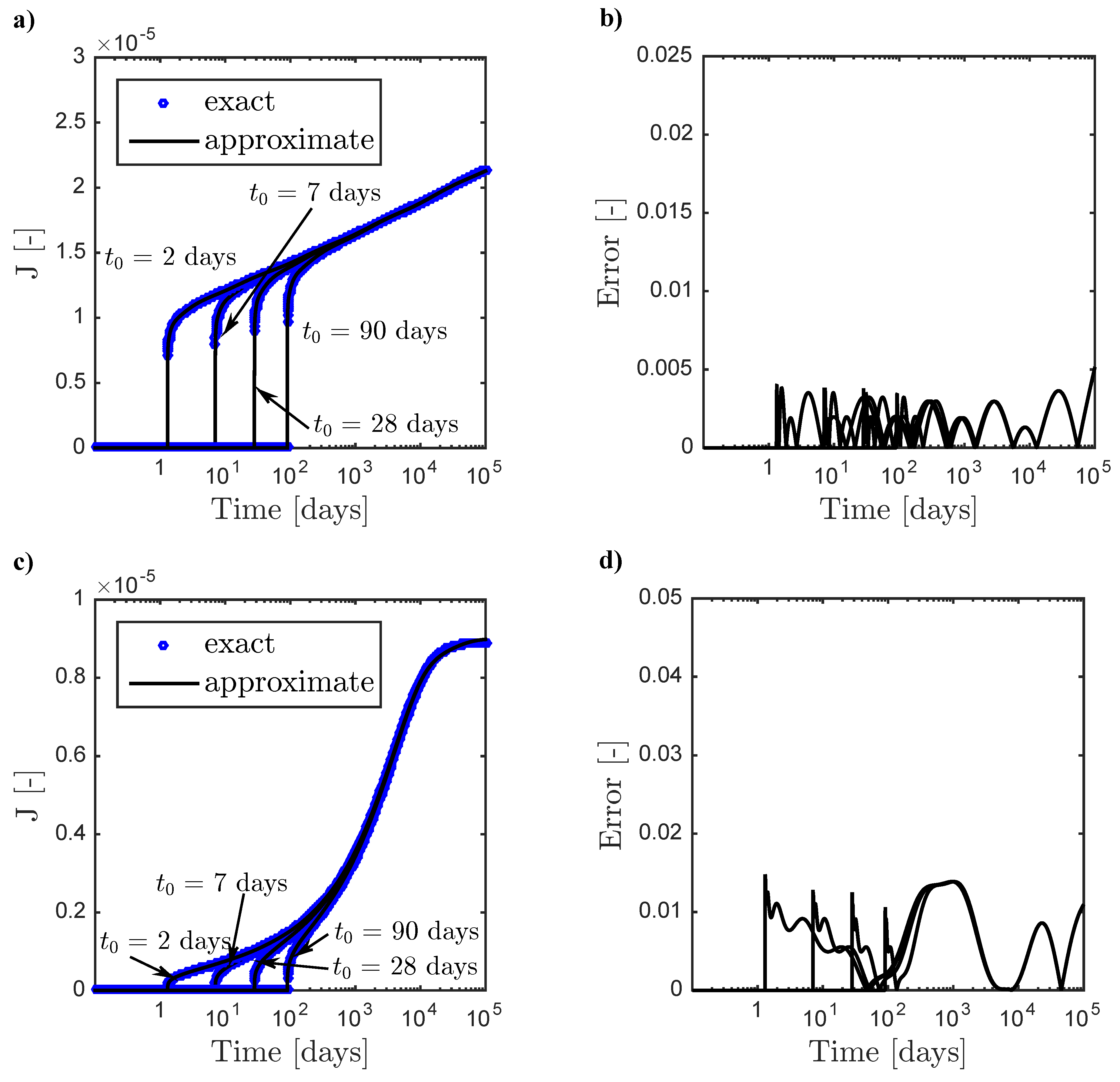

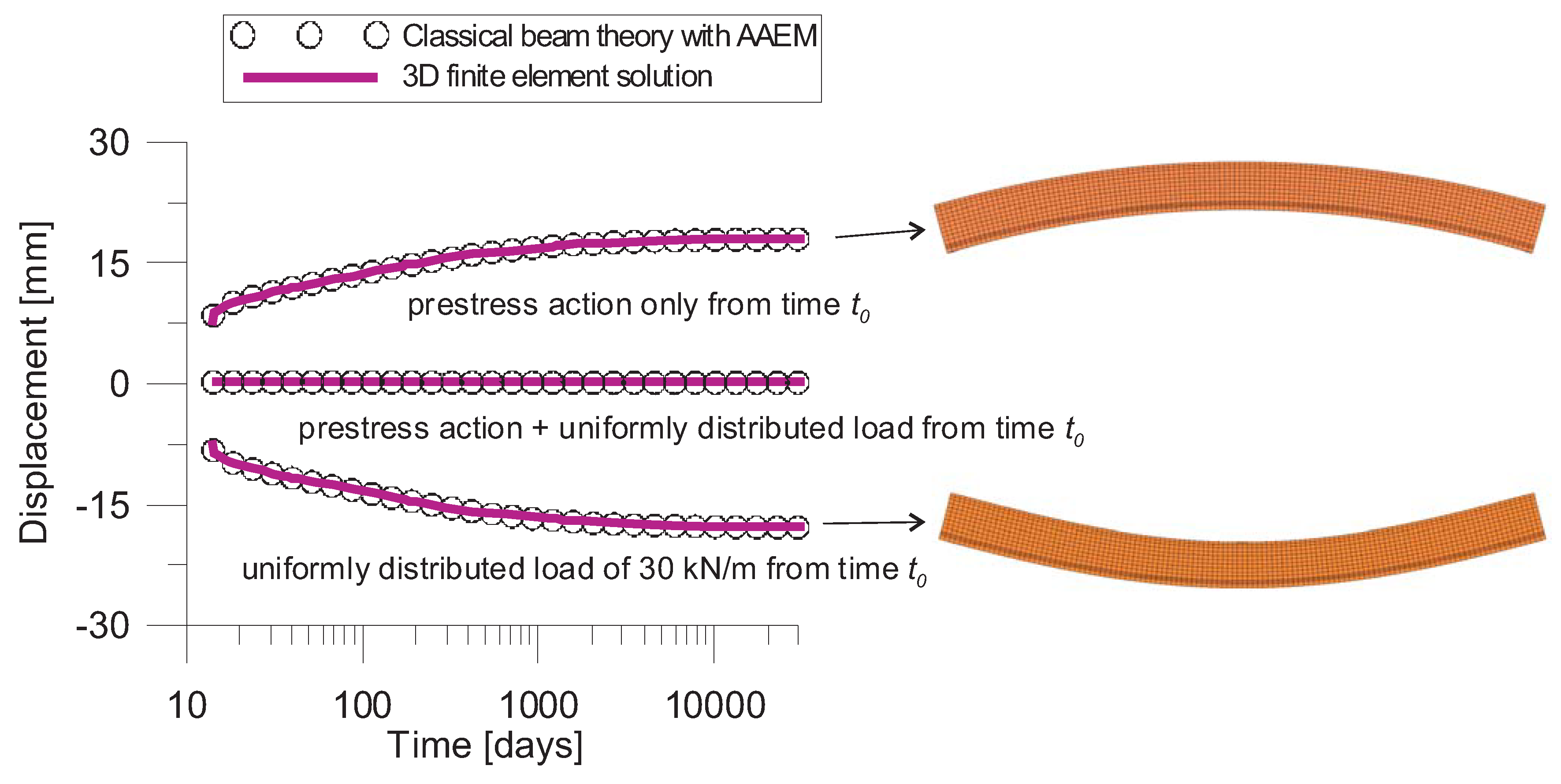
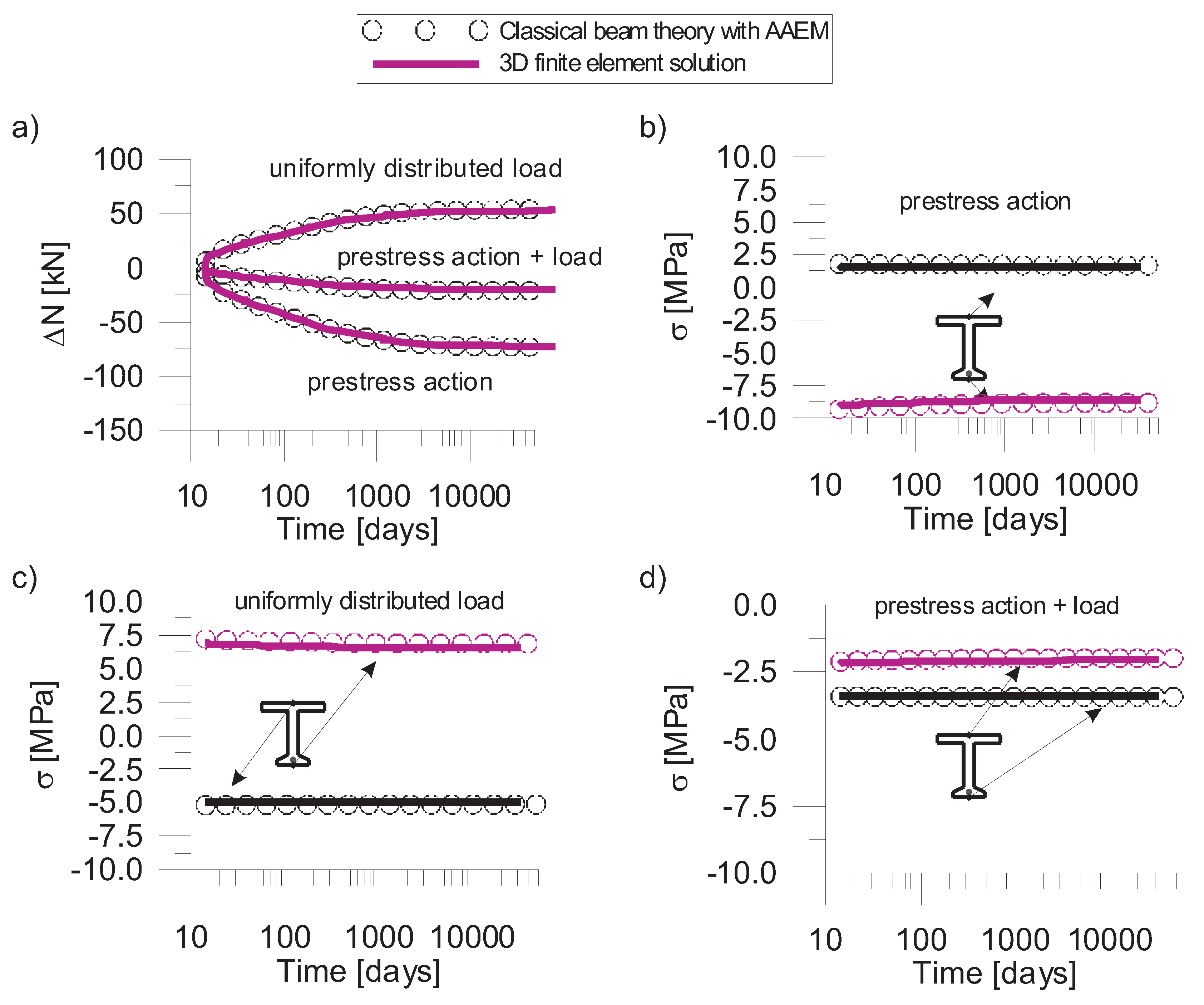
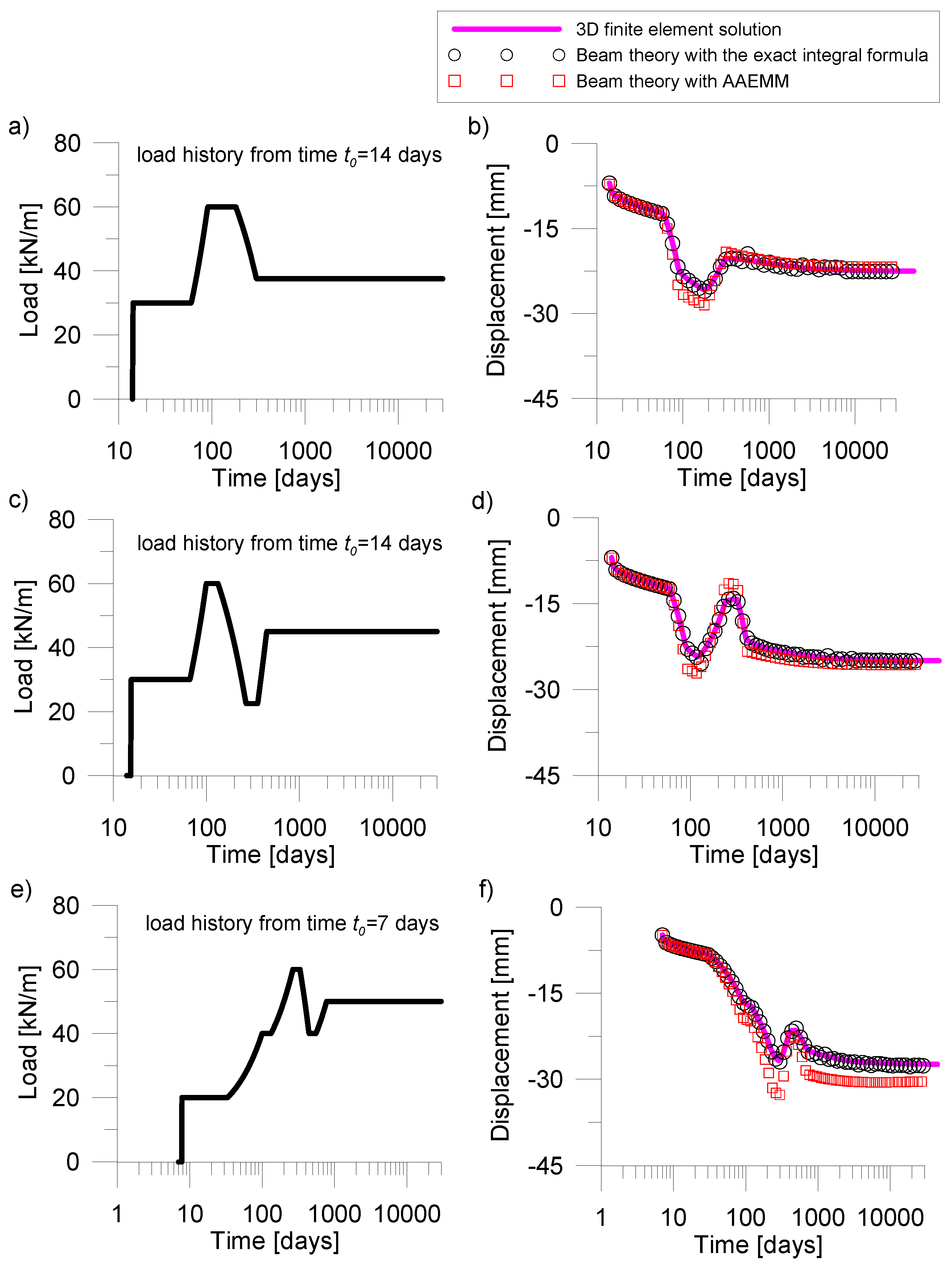
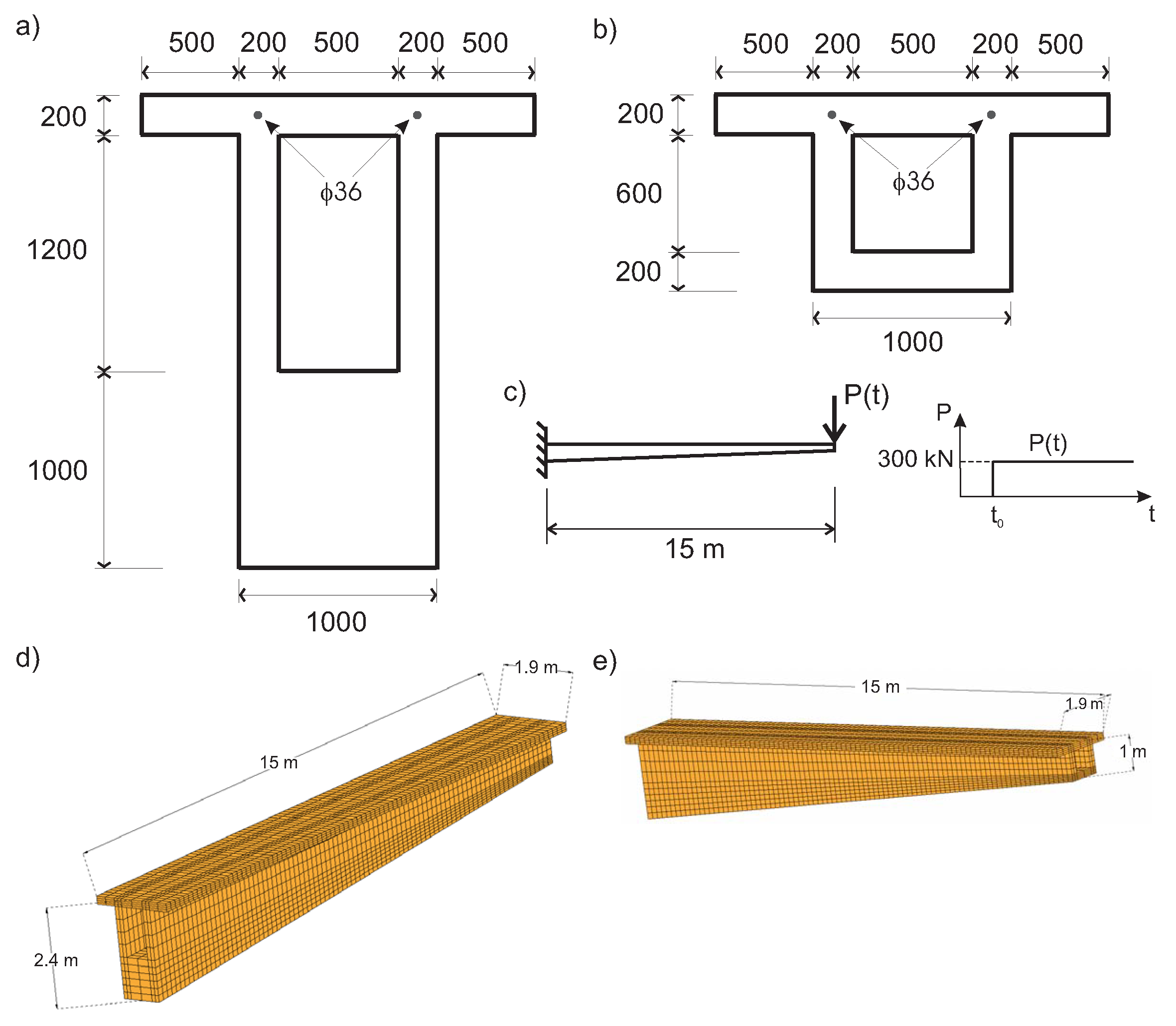
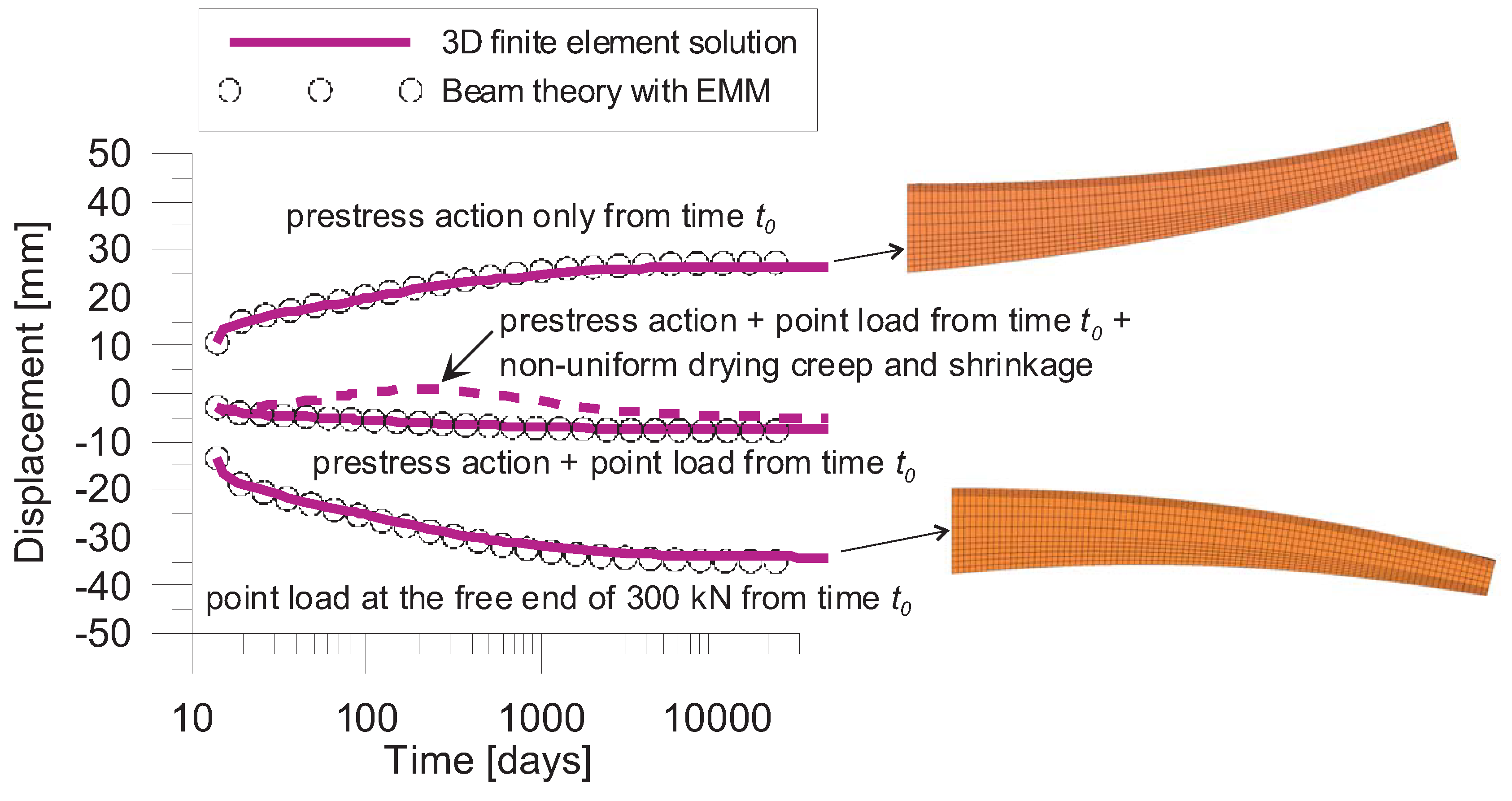


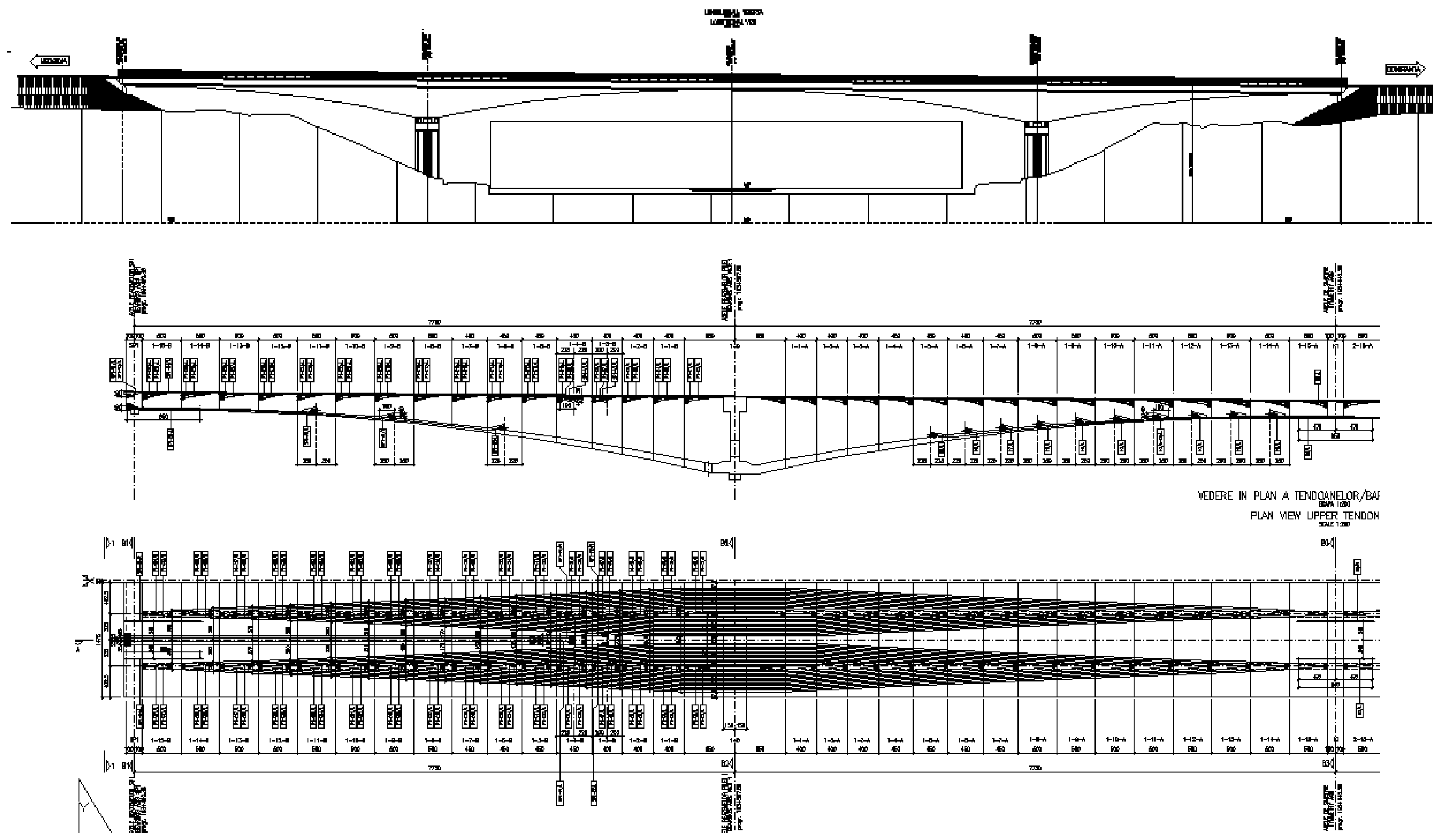
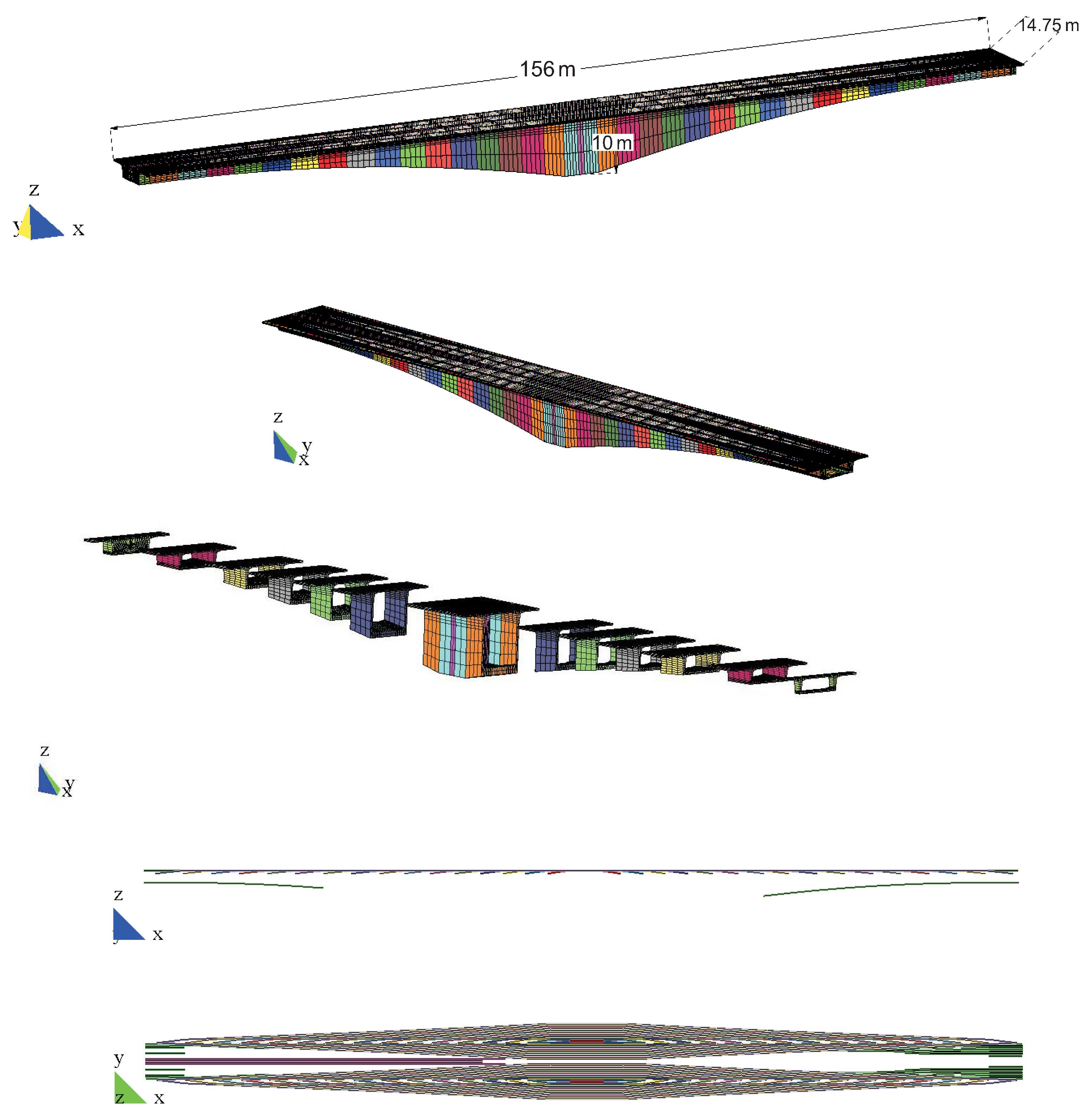

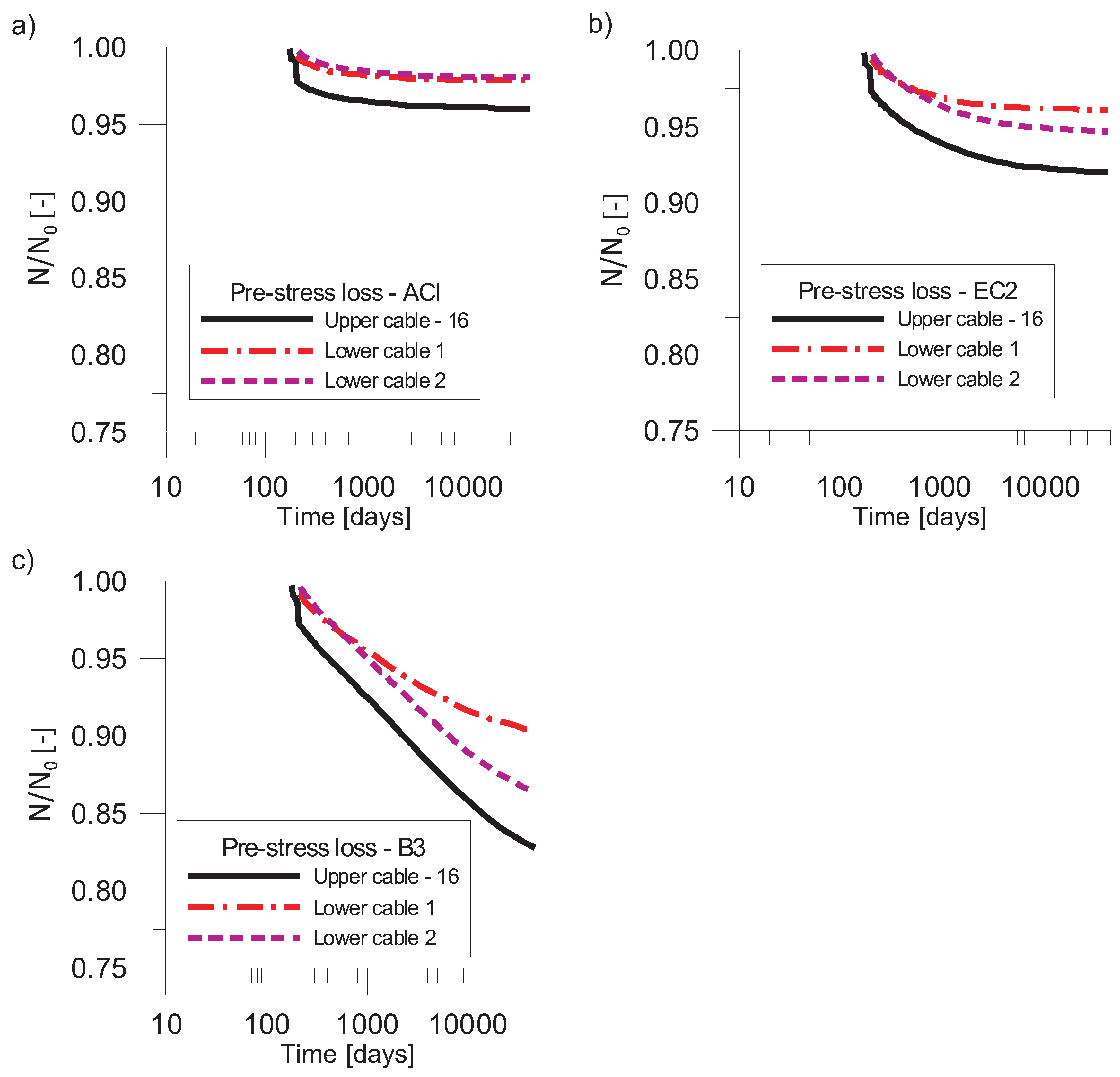

| Segment | Central Span [mm] | Side Span [mm] |
|---|---|---|
| 2 | 10.5 | 6.7 |
| 3 | 4.4 | 7.1 |
| 4 | 14.1 | 7.3 |
| 5 | 24.3 | 8.1 |
| 6 | 24.2 | 8.2 |
| 7 | 23.9 | 8.3 |
| 8 | 3.9 | 8.4 |
| 9 | 23.6 | 8.6 |
| 10 | 13.1 | 17.5 |
| 11 | 11.7 | 15.8 |
| 12 | 9.2 | 2.6 |
| 13 | 5.4 | −2.7 |
| 14 | −1.4 | −11.7 |
| 15 | −2.6 | 4.0 |
| 16 | 10.6 | 10.3 |
| Name | Position | Tendons | |||
|---|---|---|---|---|---|
| Strand Type | Number of Strands | Area [mm] | N [kN] | ||
| Cable 1 to 16 | Upper Pier | 0.6 normal | 12 | 1668 | 2335 |
| Lower cable | Lower side and central span | 0.6 compact | 22 | 3630 | 5082 |
| Upper cable | Upper side span | 0.6 normal | 12 | 1668 | 2335 |
| Bars | |||||
| [mm] | Area [mm] | N [kN] | |||
| thread-bars | Key segment | 36 | 1017 | 722 | |
| thread-bars | Abutment segments | 36 | 1017 | 722 | |
| Segment | Upper Slab [mm] | Lateral Slab [mm] | Lower Slab [mm] |
|---|---|---|---|
| Diaphragm | 2304.70 | 4502.73 | 2200.00 |
| 1 | 517.82 | 865.58 | 1237.01 |
| 2 | 306.77 | 880.87 | 1143.65 |
| 3 | 306.82 | 885,71 | 1042.86 |
| 4 | 306.85 | 891,24 | 948.36 |
| 5 | 304.73 | 897.59 | 860.17 |
| 6 | 305.42 | 907.09 | 768.49 |
| 7 | 303.34 | 720.68 | 675.22 |
| 8 | 303.34 | 727.78 | 599.76 |
| 9 | 303.34 | 758.49 | 532.44 |
| 10 | 303.33 | 784.54 | 467.16 |
| 11 | 303.34 | 814.14 | 411.95 |
| 12 | 303.34 | 846.21 | 366.76 |
| 13 | 303.33 | 878.55 | 331.61 |
| 14 | 303.33 | 927.53 | 306.51 |
| 15 | 303.34 | 934.43 | 291.44 |
| 16 | 303.34 | 956.69 | 286.42 |
| B1 | 619.38 | 6869.47 | 700.00 |
| B3 | 303.33 | 926.99 | 286.42 |
| Section | Area [m] | Segment Length [m] | Volume [m] | D [mm] |
|---|---|---|---|---|
| Diaphragm | 70.667 | 0.5 | 35.333 | 2437.007 |
| 1 | 23.111 | 3.5 | 80.891 | 603.483 |
| 2 | 19.117 | 4 | 76.468 | 514.435 |
| 3 | 17.812 | 4 | 71.252 | 499.910 |
| 4 | 16.590 | 4 | 66.363 | 485.120 |
| 5 | 15.446 | 4.5 | 69.511 | 470.055 |
| 6 | 14.259 | 4.5 | 64.169 | 453.102 |
| 7 | 12.258 | 4.5 | 55.162 | 403.015 |
| 8 | 11.410 | 4.5 | 51.349 | 389.807 |
| 9 | 10.654 | 5 | 53.274 | 377.120 |
| 10 | 9.922 | 5 | 49.610 | 363.916 |
| 11 | 9.302 | 5 | 46.508 | 352.999 |
| 12 | 8.794 | 5 | 43.972 | 341.620 |
| 13 | 8.482 | 5 | 42.410 | 336.480 |
| 14 | 8.136 | 5 | 40.682 | 327.697 |
| 15 | 7.949 | 5 | 39.743 | 323.048 |
| 16 | 7.880 | 5 | 39.402 | 321.317 |
| B1 | 9.417 | 2 | 36.352 | 370.549 |
| B3 | 8.317 | 1 | 8.3175 | 334.471 |
© 2020 by the authors. Licensee MDPI, Basel, Switzerland. This article is an open access article distributed under the terms and conditions of the Creative Commons Attribution (CC BY) license (http://creativecommons.org/licenses/by/4.0/).
Share and Cite
Di Luzio, G.; Cedolin, L.; Beltrami, C. Tridimensional Long-Term Finite Element Analysis of Reinforced Concrete Structures with Rate-Type Creep Approach. Appl. Sci. 2020, 10, 4772. https://doi.org/10.3390/app10144772
Di Luzio G, Cedolin L, Beltrami C. Tridimensional Long-Term Finite Element Analysis of Reinforced Concrete Structures with Rate-Type Creep Approach. Applied Sciences. 2020; 10(14):4772. https://doi.org/10.3390/app10144772
Chicago/Turabian StyleDi Luzio, Giovanni, Luigi Cedolin, and Carlo Beltrami. 2020. "Tridimensional Long-Term Finite Element Analysis of Reinforced Concrete Structures with Rate-Type Creep Approach" Applied Sciences 10, no. 14: 4772. https://doi.org/10.3390/app10144772





